A crane is a machine that is capable of raising and lowering heavy objects and moving the objects from one place to other. An overhead crane usually consists of three separate motions:
- The first motion is the hoist, which raises and lowers the material.
- The second is the trolley (cross travel), which allows the hoist to be positioned directly above the material for placement.
- The third is the gantry or bridge motion (long travel), which allows the entire crane to be moved along the working area.
Cranes are distinguished from hoists, which can lift objects but cannot move them sideways. The design of overhead cranes varies widely according to their major operational specifications such as type of motion of the crane structure, weight, and type of the load, location of the crane, geometric features, operating regimes, and environmental conditions.
Selecting the right type of overhead crane is critical to streamlining workflow and maximizing productivity. Many factors are taken into consideration which include:
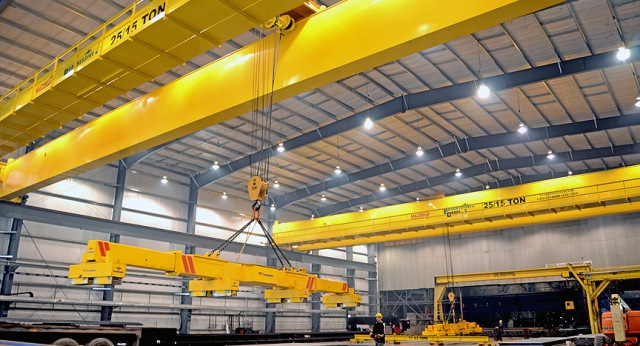
Cross Travel crane
Overhead crane test questions and answers :
- What bridge capacity is required?
- How often is the crane to be used?
- What span is required?
- How long is the runway travel?
- How high must the hoist lift?
- Is the bridge going to be supported by the building, self-supported, or both?
- Is the bridge going to be indoors or outdoors?
- How is the crane powered? All motorized push-pull, hand geared, or a combination?
- If motorized, how fast? Single or dual speeds? Variable frequency drives
- What voltages are required?
- What type of control? Pendant from the hoist, separate track, or remote control?
- Any special features? Cabs, walkways, horns, lights?
- What specifications, codes, or local regulations are applicable?
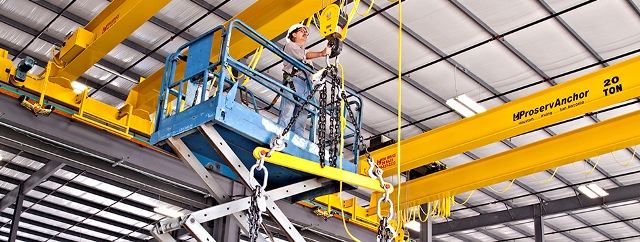
Long Travel crane
Types of overhead travel crane
There are various types of overhead cranes with many being highly specialized, but the great majority of installations fall into one of four categories:
Single Girder Cranes
The crane consists of a single bridge girder supported on two end trucks. It has a trolley hoist mechanism that runs on the bottom flange of the bridge girder.
Double Girder Bridge Cranes
The crane consists of two bridge girders supported on two end trucks. The trolley runs on rails on the top of the bridge girders.
Gantry Cranes
These cranes are essentially the same as the regular overhead cranes except that the bridge for carrying the trolley or trolleys is rigidly supported on two or more legs running on fixed rails or other runways. These “legs” eliminate the supporting runway and column system and run on a rail either embedded in or laid on top of the floor.
Monorail
For some applications such as production assembly lines or service lines, only a trolley hoist is required. This type of crane is designed using I-beams like those found in ceiling structures of many factories. The trolleys run along the flat surface on the bottom horizontal bars of the beam. The hoisting mechanism is similar to a single girder crane with the difference that the crane doesn’t have a movable bridge and the hoisting trolley runs on a fixed girder.

Single vs double girder crane
Which Crane should you choose – single Girder or Double Girder
Based on the CMAA (Crane Manufacturers Association of America) specifications, both single and double girder cranes are equally rigid, strong, and durable. The principle difference between single and double girder cranes is hook height (how far above the floor your hoist will lift).
Double girder cranes typically allow 18-36 inches higher lift, because the hoist is placed between the cross girders rather than under them. Therefore, the depth of the cross girder is gained by switching to double girders.
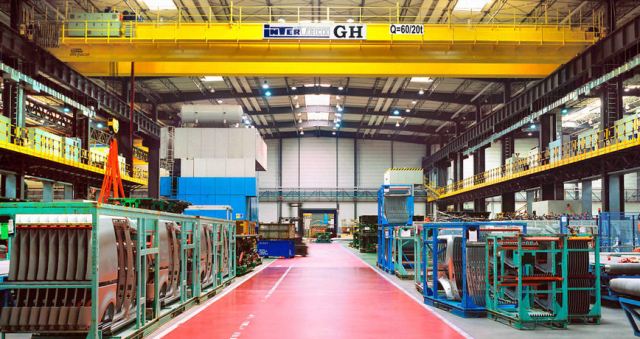
Overhead crane cost
Cost Considerations; single girder cranes may cost less for several reasons:
- Only one girder is required
- The trolley is simpler
- Fright expenses are reduced
- Installation is faster
- Runway beams are lighter
However, not all cranes should be designed with a single girder. Generally, if the crane has to handle more than 15 tons or the span is more than 80 feet, a double girder crane is a preferred option. Double girder cranes are also highly suitable where the crane needs to be fitted with walkways, cabs, magnet cable reels, or other special equipment.
The Crane Manufacturers Association of America (CMAA) is pretty much the head kahuna of the US crane industry. Every reputable crane builder conforms to CMAA Spec 70 (for double girder cranes) or CMAA Spec 74 (for single girder cranes).
Crane Configuration
- Under Running (U/R)
- Top Running (T/R)
Under running crane
Under running or underslung cranes are supported by using suspension-type support that is connected to the bottom of the frame.
The crane wheels are supported from the bottom of the flange of the crane beams which act as a crane rail and usually only span a portion of the column-to-column span of the structure.
Under running, cranes are typically available in standard capacities up to 10 tons (special configurations up to 25 tons and over 90 ft spans). Underhung cranes offer excellent side approaches, and close headroom, and can be supported on runways hung from existing building members if adequate.
The under-running crane offers the following advantages:
- Very small trolley approach dimensions meaning maximum utilization of the building’s width and height.
- The possibility of using the existing ceiling girder for securing the crane track.
The following are some limitations to under-running cranes:
- Hook Height: Due to the location of the runway beams, hook height is reduced
- Roof Load: The load applied to the roof is greater than that of a top running crane.
- Flange Loading: Lower flange loading of runway beams requires careful sizing; otherwise, you can “peel” the flanges off the beam

Top Running Crane
The crane bridge travels on top of rails mounted on a runway beam supported by either the building columns or columns specifically engineered for the crane.
Top running cranes are the most common form of crane design where the crane loads are transmitted to the building columns or free-standing structures.
These cranes have the greatest variation in capacity, span and service class and usually span the full width of the framing supports. These are available in both single girder and double girder configurations.
Overhead crane components
- The function of a crane is to move the lifted load horizontally and longitudinally in the building.
- The lifted load is usually supported with a hook which is cabled to a hoist.
- The hoist is supported by a trolley that moves horizontally along the crane bridge.
- The crane bridge is connected to a number of crane trucks at each end depending on the capacity and span.
- The crane trucks can have 2, 4, or 8 wheels based on the capacity of the crane. The wheels ride along a crane rail which is supported by runway beams.

Crane components
Bridge
The Bridge is the principal structural component of an overhead crane. It spans the width of the building and comprises one or more load-bearing beams or girders. These may be fabricated steel box girders or rolled-steel joists. The bridge carries the hoist trolley, which travels along the length of the girders during operation.
Runway
The track and support system on which the crane operates.
The runway girders are usually considered a part of the building structure and are designed accordingly.
Runway Rail
The rail is supported by the runway beams on which the crane travels.
End trucks
Located on either side of the bridge, the end trucks house the wheels on which the entire crane travels. It is an assembly consisting of structural members, wheels, bearings, axles, etc., which supports the bridge girder(s) or the trolley cross member(s).
Electric drive motors typically two-speed or variable-speed units power the wheels and move the crane into the required position.
Brakes are mounted on the drive motors and are essential to prevent uncontrolled loads from becoming dangerous, and are often electrically operated. Electrical limit switches cut power to the drive motors and prevent the crane from colliding with the building structure at the end of the travel range.
Overhead crane hoist
Hoist
A hoist mechanism is a unit consisting of a motor drive, coupling, brakes, gearing, drum, ropes, and load block designed to raise, hold and lower the maximum rated load. The hoist mechanism is mounted to the trolley.
Trolley or Crab
The ‘crab’ is the ‘cross travel unit’ from which the hook is lowered and raised. A top-running trolley on a double girder crane runs on rails fitted to the top of the crane bridge. An underhung trolley on a single-girder crane runs on the bottom flange of the crane beam, with drive units connected directly to the trolley. The trolley carries the electric wire rope hoist that supports the load block and hooks through a system of pulleys. A variable-speed AC motor on the hoist drives the load up or down. Limit switches prevent the load block from colliding with the trolley.
Bumper
Bumper (Buffer): An energy absorbing device intended for reducing impact when a moving crane or trolley reaches the end of its permitted travel, or when two moving cranes or trolleys come into contact. This device may be attached to the bridge, trolley, or runway stop.
Controls
Controls for an EOT crane are usually mounted in an operator pendant or remote console and comprise various push buttons and switches that operate relays and contactors mounted on the crane.
Drive motors and the hoist motor draw substantial currents during operation and require appropriately rated contactors to switch them on and off. Variable frequency inverters provide speed control for motors where accurate positioning is essential. A master contactor is triggered by the main switch and cuts off all power to the crane if a dangerous situation occurs.
Other features on specialized cranes may include end stops, provision of a full-length platform on both girders, provision of under-bridge lighting, and provision of a closed, glazed, or air-conditioned cabin, specialized controls, etc.
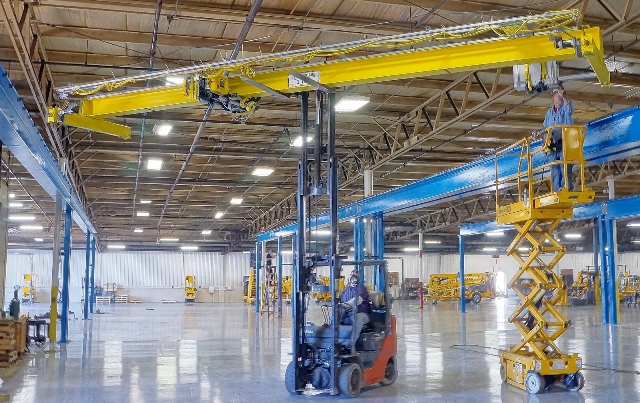
How do overhead cranes work?
Overhead cranes cover a rectangular area, moving a load side to side and backward and forward.
They typically incorporate a top running trolley hoist which moves along the top of the two bridge beams on its own set of wheels for increased headroom under the crane; also called a top running crane.
A gantry crane is a crane built atop a gantry, which is a structure used to straddle an object or workspace. They are also called portal cranes, the “portal” being the empty space straddled by the gantry.
A gantry crane is a type of overhead crane that is similar to a bridge crane, but instead of moving on suspended runways, the crane uses legs to support the bridge, trolley, and hoist. These legs travel on tires or on rails that are embedded in the floor or ground structure.

The most read

Overhead Cranes
- What are the parts of an overhead crane?
- What is the purpose of an overhead crane?
- How much does an overhead crane cost?
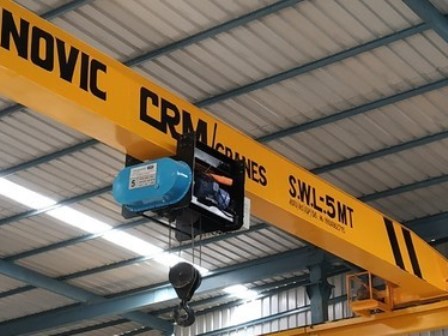
Overhead crane specifications
The specifications depend on the essential terminology when using overhead cranes, each part, part layer, must be defined and specified.
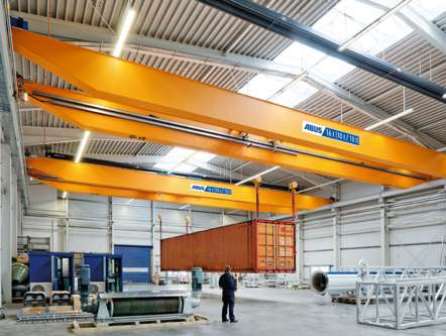
Overhead Crane Test Questions and Answers
- Crane operator interview questions and answers
- Rigging test questions and answers
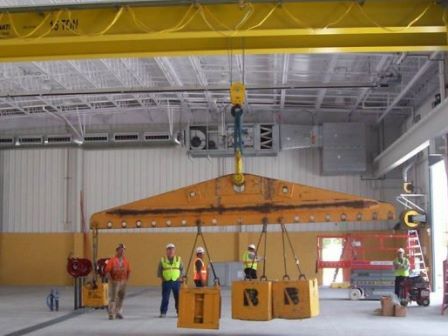
Overhead Crane Safe Work Procedure
What happens when there are structural defects in an overhead crane?
